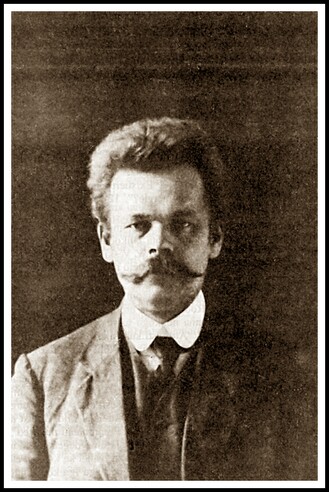
|
Wilhelm Robert Karl Anderson |
[Piret Kuusk, Indrek Martinson, Akadeemia 2 (1997) 358-375]
[Heino Eelsalu, Akadeemia 9 (1997) 1975-1977]
[Translated from Estonian by Stefan Groote]
The list of lecture courses and practical works at the University of Tartu, Estonia, in the first half year of 1940 notifies that at that time three men were working at the department of mathematics and science in the field of astronomy: the ordinary professor Taavet Rootsmäe (cand. math.), the astronomer-observer Ernst Öpik (dr. phil. nat., member of the Estonian Academy of Science) and the docent Wilhelm Anderson (dr. phil. nat.). The life and activities of Taavet Rootsmäe and Ernst Öpik have been mentioned from time to time but Wilhelm Anderson is nowadays nearly unkown in Estonia [more detailed informations about Wilhelm Anderson's scientific ideas and publications are available to the physically interested reader in the annual of the Estonian Physical Society of 1994 (Kuusk, Martinson, 1995)].

Anderson, Wilhelm Robert Karl (1880 - 1940)
The life
In the Estonian Historical Archives where the archive (fond) of the University of Tartu is kept Wilhelm Anderson's personal files are also found (EAA, f 2100, n 2, s 22). Looking through it we find his handwritten curriculum vitae, written as appendix to the application for the postdoctoral lecture qualification (Habilitation) on april 21st, 1934:
I was born in 1880 in Minsk where my father was teacher at the higher school (Gymnasium)
In 1894 my father was elected as professor of the University of Kazan (on the field of Finno-Ugric languages). Therefore we moved there.
In 1905 my father died.
In 1909 I graduated from the department of mathematics and science of the University of Kazan.
From 1910 to 1918 I was teacher at the higher school of Samara.
From 1918 to 1920 I was teacher at the technical highschool (Technikum) in Minsk.
In 1920 we moved to Tartu.
In 1923 I obtained the master of astronomy at the University of Tartu. The title of my master thesis was "About the possibility of the existence of cosmic dust in the sun's corona" (Z. Phys. 28 (1924) 299-324).
In 1927 I received the diploma as dr. phil. nat. My dissertation was entitled "The physical nature of the sun's corona" (Z. Phys. 33 (1925) 273-301, 34 (1925) 453-473, 35 (1926) 757-775, 37 (1926) 342-366), 38 (1926) 530-548, 41 (1927) 51-80). |
Appended to the application for the postdoctoral lecture qualification is also the list of scientific works (36 entries) and the thesis with the title "Existiert eine obere Grenze für die Dichte der Materie und Energie?" ("Is there an upper bound for the density of matter and energy?", 12 typewritten pages in German).
The council of the department first of all demanded for an "assertion of the knowledge of the Estonian language according to paragraph 72 of the University Act". On May 25th, 1935 lector J.W. Veski exposed the certificate that "W. Anderson is able to express his ideas in Estonian in a completely understandable way".
Following this the appointment board consisting of prof. David Rootsman (Taavet Rootsmäe) and prof. Johan Vilip began its work and presented its report on october 16th, 1935 to the council of the department. The lecture about the "atomistic time structure" was held on may 13th, 1936, and on may 19th, 1936 the council of the university confirmed the rights of an assistant professor.
In the second half of 1936 Wilhelm Anderson gave a lecture series on the commendatory subject "About the interior of stars" (from the annual report: "in the first half semester there were two lectures and in the second there were three. Two lectures were left out - the first because two listeners had left Tartu, the second because there were funerals for prof. Tennmann"), in the first half of 1937 about "The interior of stars and the degenerate matter" (from the annual report: "Listeners were usually three, sometimes two. Besides the three students named above, also prof. Rootsmäe was present nearly every time"), and in the second half of 1937 "Questions of equilibrium for the sun's chromosphere" (from the annual report: "Listeners were in the beginning three, in the meantime two and in the end again three."). In the personal files there is found also the application for a lecture series "Critical overview over the theory of the sun's corona", to be read in the first half of 1938, but because of the worsening of his health this lecture series remained unaffirmed by the government of the university and the lectures and practical works unproclaimed. Unfinished remained as well his last scientific article in the Tracts of the University of Tartu, "On the possibility of the use of Saha's ionization equation for extremely high temperatures" (Anderson, 1939) which was endued by the leader of the observatory in Tartu with the German remark: "Der Verfasser, Dr. phil. nat. Wilhelm Anderson, ist durch eine plötzlich eingetretene schwere Erkrankung zur Zeit verhindert, eine beabsichtigte Ergänzung zu der vorliegenden Arbeit druckfertig zu machen" ("The author, Dr. phil. nat. Wilhelm Anderson is prevented by a suddenly approached, heavy illness to rewrite an intended addition to this article").
In october 1939, Wilhelm Anderson together with a lot of other baltic Germans left Estonia. Because of his poor health he did not resist the wears and tears of the resettlement. His younger brother Walter Anderson, ordinary professor for Estonian and comparative folklore at the University of Tartu, finishes his personal bulletin with the sad message to the secretary of the University of Tartu:
"I notify that my brother dr. phil. nat. Wilhelm Anderson, docent of the University of Tartu, died on march 26th this year in Meseritz (hospital of Meseritz-Obrawalde).[-]
Gotenhafen, 28.3.1940 (Einwanderer-Zentralstelle)"
|
The town of Meseritz is nowadays known under the name Miedzyrzecz and is located in Poland, approx. 70 km to the east of Frankurt an der Oder.
Concerning Wilhelm Anderson's younger brother Walter Anderson (10.10.1885, Minsk - 23.8.1962, Kiel) and their father Nikolai Anderson (6.10.1845, Viru-Jaagupi commune - 22.3.1905, Narva-Jõesuu) detailed informations are available by the ENE (Estonian National Encyclopedia) as well as by a majority of national books dealing with the history of language and national poetry science. Nikolai Anderson was educated at the University of Tartu and finishing 1870 he went to Minsk. In 1894-1905 he worked as a professor of Finno-Ugric languages at the University of Kazan. He published two larger studies on the field of language science, "Studien zur Vergleichung der indo-germanischen und finnisch-ugrischen Sprachen" (1879) and "Wandlungen der anlautenden dentalen Spirans im Ostjakischen" (1893). Walter Anderson was an internationally known and reknowned scientist on the field of fairy tales and national songs. He also worked on the field of numismatics. After leaving Estonia, Walter Anderson worked as a professor at the University of Königsberg (1940-1945) and as an incumbent at the University of Kiel (1945-1953). He was married with the daughter of the orthodox priest Bobkowski with whom he had two children.
Up to the end of his life Wilhelm Anderson remained bachelor, living together with his brother (in the beginning Lossi street 15-7, then Veski street 30-2, and finally before resettlement Narva street 69-3). The brother supported him also financially because as assistant professor who gave one lecture a week, Wilhelm Anderson got the humble salary of 175 estonian crowns per semester. He did not have an office or table at the university but worked at home. Even in case of scientific articles he named his private address - before becoming an assistant professor he had no academic working place at all. But he published his scientific articles in at that time leading journals: the "Zeitschrift für Physik" in Germany and the "Philosophical Magazine" in England. Later when he had become assistant professor he started to publish his works in the "Tracts of the University of Tartu" ("Tartu Ülikooli Toimetused").
Physics of the sun's corona
The outmost, rarest part of the sun's atmosphere which can be observed only in case of eclipses is named sun's corona. In the first decades of the 20th century the spectrum of the corona was precisely measured, consisting of a continuous spectrum with single bright radiation lines and dark absorption lines. But it was unknown what should produce such a spectrum because neither the consistence of the corona nor the physical circumstances were known. Scientists did not succeed in identifying some of the radiation lines. It was expected to be possible that these lines were due to a yet unknown element coronium. The swedish chemist Svante Arrhenius (1859-1927) tried to explain the continuous spectrum by the assumption that the corona contains cosmic dust, i.e. small solid or fluid motes. Also Ernst Öpik (Öpik, 1922) imagined cosmic dust. In order that the cosmic dust was stable, light pressure and gravitational forces had to be balanced. Other possible physical processes were not considered by Arrhenius.
In his master thesis entitled "On the possibility of cosmic dust in the sun's corona" (Anderson, 1924) Wilhelm Anderson started to critically overview Arrhenius' hypothesis. Because the temperature of the sun exceeds thousands of Celsius degrees, it can be assumed that there is a continuing transpiration from the surfaces of the solid and fluid particles. Starting from this assumption, Anderson found a lifetime for the particles which was proportional to its initial radius and density and inversely proportional to the transpiration rate per surface. Density and transpiration rate depend on the matter as well as on the temperature. Anderson assumed that the matter is carbon, the mean temperature of the corona is 3500 degree Celsius, and the initial diameter of the particles is 0.0001 cm. He found that the particle disappears by transpiration within 0.44 seconds. As the temperature decreases for larger distances from the sun's surface, Anderson calculated a large table of particles' lifetime in dependence on the distance from the sun's surface. It turned out that all dust particles which were closer to the sun's surface than a single sun's radius disappeared within a few minutes. But a process which could supply new dust particles with sufficiently high rate was not known. Indeed it was not possible to explain the corona's spectrum by assuming that the corona contains a lot of cosmic dust. In the following Anderson considered several changes which were possible: to replace carbon by another element, to increase the radius of the particles, to abstain from the assumption that the dust particles are ideal black bodies, etc. But none of these changes gave the desired results. Due to this, Arrhenius theory is toppled, Anderson claimed in his conclusion.
Anderson's dissertation "The physical nature of the sun's corona" appeared in the years 1925-1927 in six articles in "Zeitschrift für Physik", a journal which in its time and its field was one of the most influencial (Anderson, 1925-1927). Anderson started with the assumption that because the corona cannot consist of solid or fluid particles it has to consist of gas. He assumed that this gas consists of free electrons and he compared this hypothesis with other theories for the corona's constitution. In his opinion the other theories had larger problems to explain the observations. In detail he compared his electron gas hypothesis with the situation that the corona consists of a electric neutral mixture of free electrons and protons (nowadays known as plasma). He found that the theory of the electron gas is in better agreement with the brightness distribution of the sun's spectrum. But there is a repulsion force between free electrons which forces them to disperse. Anderson noted that the electron gas theory has problems with this but he held that, assuming for a yet unknown reason the repulsion force in the sun's corona does not act, his theory explains much better than any other the observed properties.
In his work Anderson dealed also very thoroughly with the sun's spectrum and came to the conclusion that there are no gases known which correspond to the spectrum of the corona. He critisized other scientists, e.g. H. Ludendorff who assumed that the corona consists of a mixture of electrons and protons, and J. Woltjer who claimed that the corona contains positive ions whose radiation's main part is located in the ultraviolet region. Nowadays we know that the last assumption is closest to reality.
From Anderson's articles it is obvious how well informed he was about the works of other authors. The main part of his articles was based on the critical view at the viewpoints of other scientists. He also knew how to use existing theories, observation data and expertimental results to explain and support his hypotheses.
In his works Anderson assumed like all other scientists of his time that the temperature of the corona is a few thousand degree Celsius. A half decade later the later atom physics professor at the University of Lund, Bengt Edlén (1906-1993) showed that the spectral lines found in the corona's spectrum are due to the highly charged ions Fe13+ and Ni16+ from which one can conclude that the temperature of the corona is thousand times larger than assumed up to then, namely nearly a million degree Celsius (Edlén, 1942). However, the electron density is much smaller than in Anderson's calculations. Because of all this there are not much results in Anderson's works about the sun's corona which could be considered nowadays to be right. Nevertheless, Iosif Shklovskii considered him to be worth mentioned in his book "Physics of the sun's corona" (Shklovskii, 1965: 127), advertising his opinion about the very short life time of cosmic dust particles in the corona. He added that the same conclusion was made in 1929 by Henry Norris Russell who left Andersons work without citation, though (Russell, 1929).
The Stoner-Anderson state equation
White dwarf stars were found in the first quarter of the 20th century. From the observations one concluded that their mass is of the size of the sun's mass, the surface temperature two to three times larger than the sun's one, but the radius is comparable with the radius of the earth of about 5000 km. Therefore, their density has to be of the order 106g/cm3 or a ton per cubic centimeter. There was the question that it is indeed possible to press the ionized gas to such a large density. However, from which source the star can take the additional energy necessary in case that the cold ions recombine again to atoms, the compressibility decreases and the star have to work against the gravitational attraction during the expansion?
The answer was given by the Fermi-Dirac statistics formulated in 1926. In the same year Ralph Howard Fowler showed that inside a white dwarf star with high matter density the behaviour of the degenerate electron gas changes decisively according to the quantum mechanical rules. This avoids the paradox named above (Fowler, 1926). Among others he derived the relation between the pressure and density of the degenerate electron gas. This kind of relations are called state equations. Three year later the physics lecturer at the University of Leeds, Edmund Stoner tried to find a possible upper bound for the density of the white dwarf star in the framework of the degenerate electron gas and came basically to the same state equation (Stoner, 1929).
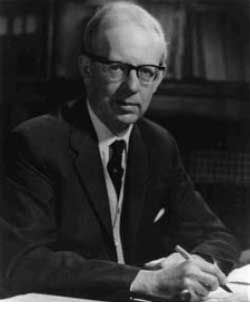
Edmund C. Stoner
Approximately at the same time, in the beginning of 1929, based on Fermi's article of 1926 Wilhelm Anderson found an analogous relation between the pressure and density of the degenerate electron gas. At the same time he noticed that this equation was derived from the assumption that the pressure is small and the speed of the electrons is non-relativistic. For higher pressures the speed of the electrons approaches the speed of light and the electron mass m0 has to be replaced by the larger, relativistic mass. Starting with this idea he derived a new relation between the pressure and density of the degenerate electron gas which was different from the non-relativistic one by a proportionality factor and a power: in Stoner's non-relativistic state equation the density of the electron gas was proportional to the pressure of power 5/3, in Anderson's relativistic equation the power was 4/3 (Anderson, 1929a).
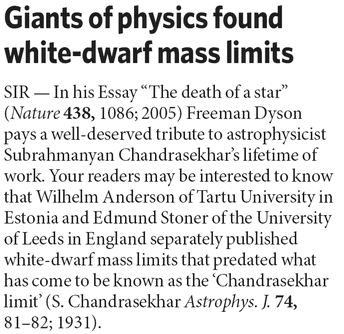
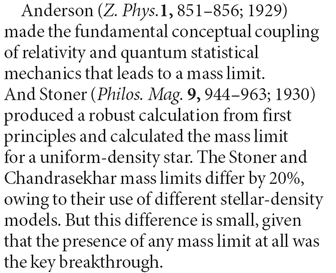

Sample from Nature March 9, 2006
When Stoner's article about a possible upper bound for the white dwarf stars (Stoner, 1929) reached Anderson, he immediately saw that the relativistic increase of the electron's mass was not taken into account and published his critical remarks (Anderson, 1929b). Stoner admitted that Anderson's criticism was basically true but did not regard his result correct (Stoner, 1930). Without citing Anderson's previous work (Anderson, 1929a) he calculated the exact equation of state and obtained as result an equation that contained the power 4/3 but a proportionality factor different from Anderson. This equation was called the Stoner-Anderson state equation.
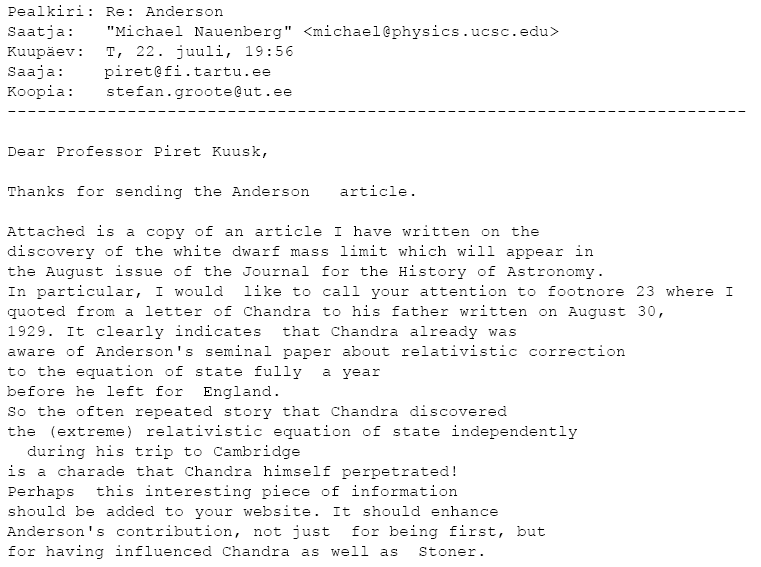
More light to the controversy!
In his book entitled "An Introduction to the Study of Stellar Structure" (Chandrasekhar, 1939), a decade later Subramanyan Chandrasekhar (1910-1995) derived a general state equation for the degenerate electron gas that in the limiting cases gave the non-relativistic relation as well as the Stoner-Anderson state equation. Giving an overview over the literature he named also his predecessors Fowler and Stoner and alongside also Anderson, advising to read in addition to his article of 1929 (Anderson, 1929a) also his later published longer article (Anderson, 1936). Chandrasekhar acknowledges that Anderson was the first who cited the importance of relativistic effects for astrophysics.
White dwarf stars - limited by density or by mass?
In 1931 Chandrasekhar proved that a star of the white dwarf type with a mass larger than 1.2 sun masses cannot be infinitely large in the hydrostatic equilibrium and have to collapse catastrophically under gravity. Such a process was later named gravitational collapse. In 1996 Werner Israel wrote a historical overview about ideas which led to today's theories of the gravitational collapse (Israel, 1996; see also Israel, 1987). Here we read:
"In the tabulation and formulae of Anderson's paper one can discern the first hints of an upper mass limit for equilibrium white dwarf configurations. But Anderson drew no such conclusion from his work."
Israel cites here Andersons article "About the limiting density for matter and energy" (Anderson, 1929b). What are the ideas presented there and why Anderson did not see in his work the consequences which contemporary science historians can see?

Subramanyan Chandrasekhar
1910-1995
One sees what one already knows and finds what one is searching for, Israel says. Anderson's search was related to the works of scientists at that time who in addition to the upper limit for the speed given by special relativity (speed of light) and the lower limit for the temperature given by thermodynamics (absolute zero point) tried to find other lower or upper limits for physical quantities. The density limit seemed naturally to be derivable from the atomistic theory: matter can be pressed together only as far as atomic nuclei and electrons do not touch each other. The corresponding density would be of the order of the nuclear density.
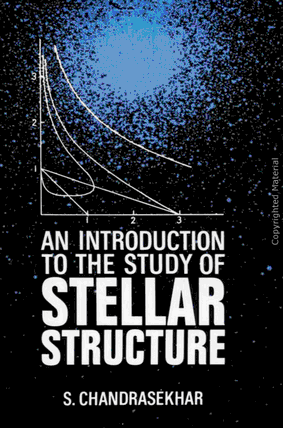
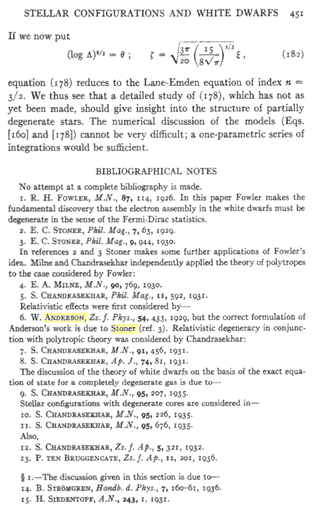
Chandrasekhar referred to Andesron in the monograph, but forgot to do so in Nobel prize talk
The largest density known at that time was the one in white dwarf stars. Stoner searched in his above mentioned article (Stoner, 1929) for a possible upper limit for the density of a white dwarf star by looking at the equilibrium conditions between the kinetic energy of the degenerate electron gas and the gravitational potential energy of the star. He found that in equilibrium the density of the degenerate electron gas (and the density of the star) have to be proportional to the square of its total mass. Anderson, who just before had emphasized the necessity of considering the relativistically amplified mass in order to derive the state equation for the degenerate electron gas (Anderson, 1929a), saw immediately that the relativistic amplification has to be included into Stoner's relation. As result he obtained a long and pretty complicated equation (Anderson, 1929b). For small densities of the degenerate electron gas the equation was the same as Stoner's, but not for large densities. His equation contained the consequence that even for an infinitely large density the star's mass is finite, so the next step could have been the determination of the maximally possible equilibrium mass. But Anderson did not calculate this limiting value. Instead, he brought arguments to prove that for high pressures his equation does not hold anyhow in cases where other physical effects come in which he did not need to consider in case of moderate densities. Among others he named problems with condensing electrons and protons which had to be taken into account for high densities. The problem of matter's maximal density was actually the main subject of the article as the title "About the limiting density for matter and energy" clearly shows. Not seeing the limiting mass in his work, Anderson still is sure about the existence of a limiting density: "Ich persönlich glaube jedenfalls, daß es eine 'Grenzdichte' geben muß; ich vermag aber nicht zu sagen, wie groß sie ist." ("Anyway, I personally believe that there have to be a 'limiting density' but I am not able to say how large it is.")
However, a few years later his opinion about the existence of a limiting density changed to the opposite - he no longer believed in the possibility of the existence of a limiting density. Already in 1931 he published a train of thoughts which should show the impossibility of the existence of a maximal density. If two bodies of maximal density collide, a part of their kinetic energy is changed to potential energy which can be identified with mass as each other kind of energy. As this additional mass increases the mass and the density of the body, the starting density could not be maximal (Anderson, 1931).
Later he wrote yet two scientific works about the limiting density of matter - the typewritten, 12 page long thesis for the application for the postdoctoral lecture qualification in 1934 and an article of 142 pages in 1936 (Anderson, 1936). In these publications he showed in different ways that the concept of a limiting density is in hopeless contradicition to special relativity. As an example we present two of his exposed reasons.
| • | If a body of maximal density would exist, this body should be absolutely incompressible and the speed of sound inside would be infinite. This is not possible if we take special relativity into account because there is no physical process with a propagation speed larger than the speed of light. |
| • | The existence of a maximal density of matter is equivalent to the existence of a maximal density of energy. From this we can derive the existence of a maximal temperature and a maximal frequency of the harmonic oscillator. However, this is not consistent with Doppler's effect, according to which an observer who is moving towards the source of the radiation records a frequency which is larger than the "maximal" frequency. |
As we see, Anderson's arguments are often very figurative and seem to be naive. Sometimes they led to the target. However, this happened far from always.
Wilhelm Anderson and us
More than a half century has passed by since Anderson's times. What we today can find in Tartu about Anderson is not much - files consisting of two yellowing items in the Archive of the University of Tartu preserved in the Estonian Historical Archives; some ten publications in the 1920-ies issues of Zeitschrift für Physik and Annalen der Physik , six articles which were published in the next decade in the Tracts of the University of Tartu (in parallel also in the Observatory Publications). The first four parts of this article rely on this written material.
However, in addition to the written words are also oral stories. Men of the grandfathers' generation who studied at the University of Tartu before war remember Wilhelm Anderson basically as the housekeeper and helping hand of his younger brother Walter. He picked up Walter's proof copies from Mattiesen's printing house and brought back the read sheats, went in place of his brother to stores and to the market for shopping. When he came from the market he put the books on the top of the basket so that it was not possible to see what was inside. When he got pocket money from his brother, he went to Werner's cafe to eat a cream cake or to the cinema. His brother, an absent minded professor, did not understand much about housekeeping so that once one could hear Wilhelm asking Walter: "Aber lieber Bruder, noch fünf Kronen für Salz!" ("But, dear brother, still five crowns for salt!"). Ivory tower Walter of course did not know that a kilogramm of salt costed only five cents. When he went to Narva-Jõesuu to spend the summer there, Wilhelm always carried a parasol in order not to get a sunstroke, and he entered the water no more than just for a moment to dowse himself. Once it happened that carrying two portions of ice cream in his one hand, he met a young girl walking towards him. He tried to hide them behind his back as if it would be something which he should not show to others.
After becoming an assistant professor he wanted to start immediately to give lectures at the university. In his inauguration lecture he said in his own accent, using the "e" instead of the estonian "õ":
"Kas te teate, mis on pergu [põrgu] temperatuur? Pergu temperatuur on see, et kui pergu seina sisse teed sermega [sõrmega] pisikese augu, siis tuleb nii hirmus palavus välja, et kervetab [kõrvetab] keik [kõik] ära saja tuhande kilomeetri kaugusel ümberringi. Vaat see on pergu temperatuur!" ("Do you know what is hell's temperature? Hell's temperature is such that if you make with your finger a tiny hole into the wall of the hell then there comes such an awful heat out that all singes down within a radius of hundreds of thousand kilometers. Look, this is the hell's temperature!")
He wanted to speak by heart at all costs, but in between he forgot the order and was terribly ashamed of it. When he had to look at the paper he turned the back to the audience and searched in the breast pocket for the sheet.
The center of astronomical research in Tartu was the Observatory. This was led by the ordinary professor of astrophysics, Taavet Rootsmäe (1885-1959). However, indeniable leader for the scientific work and the education of the students in astronomy was Ernst Öpik (1893-1985). After becoming assistant professor, also Anderson took part in the work at the Observatory (Zhelnin, 1969). Though he did not have a working place there and also had no collaboration with anyone there. He found his themes by reading new journals in the library. He started with what was appealing to him. He did not talk with others about his work and the other remember him as a strange man with whom it was difficult to talk. Tartu's mathematicians, physicists and astronomers were at that time united in the "Academic Mathematical Society" where regular meetings with talks were held. We do not find Anderson amoung the group of lecturers (Tamme, 1993). It is not known whether Anderson has visited any of the scientific conferences or missions. As an assistent professor, every year he had to give a personal report to the dean of the faculty of mathematics and science about (a) his publications, (b) other scientific activities, (c) business trips and participation in scientific conferences and general cultural meetings, (d) acknowledgements, (e) public talks, (f) other scientific duties, and (g) participation in the activity of societies. In the Estonian Historical Archives there is saved his self-written report for the academic year 1936/1937 (Wilhelm Anderson's report to the department of mathematics and science, april 28th, 1937 - EAA, f 2100, n 4, s 101, l 264). Under point (a) it contains his three articles published in the "Tracts of the University of Tartu", but the report continues with the laconic final sentence: "Concerning points (b-g) I have nothing." It seems that scientific publications were his only way to correspond - also with those who worked with him in Tartu.
But how did it happen that the shy crank who did not find a right place among the people published that kind of articles which contain some of at that time essentially new results as we now see? Keep in mind though that the mass limit for the white dwarf star was one of the results for which Chandrasekhar obtained the Nobel prize in physics in 1983.
Maybe the word "calculation" is the real thread which allows us to obtain a kind of explanation. Since the times of Galileo Galilei physics has commanded the language of mathematics to present its threads of thoughts. Using the measurements obtained from experiments, theoretical physicists try to find algebraic and/or differential equations, solutions of which together with necessary additional conditions would allow to predict the results of new experiments in the domain of observable physical effects. This domain of observable physical effects is called the validity domain of the equation, giving mostly useless results outside of this domain (some of the physical quantities contained in the formula might take infinitely large values, is in some other sense not to determine, or is simply not in numerical agreement with the experimental data). It is necessary to differentiate between the mathematical domain and the physical area of application. The first one belongs to the area of mathematical science and is given by mathematical constraints given to the occuring quantities (differentiability of the functions, convergence of integrals etc.). The physical area of application is given by the suitability of the describing physical effects in terms of formulas. An essential role plays the physical intuition in areas to where experiment and observations (still) do not reach. It might be that the mathematical domain of physical formulas is broader than the physical area of application assumed for their derivation and it might come out that formulas describe correctly also such phenomena which are outside of the assumed physical area of application. Eugene P. Wigner (1902-1995), one of the fathers of quantum mechanics and Nobel prize laureate of 1963, called such kind of cases a wonder because "we have found from our formulas something we never had put in" (Wigner, 1960). This means that if we gear with such kind of formulas and rely on them, we can reach places which would have been unreachable without these formulas. The large majority of physicists do not rely that much on their formulas. They rely more on their physical imagination and intuition. However, sometimes we could allow ourselves to take the formulas totally seriously and to see, where they lead us.
According to his education, Anderson was a mathematician. He liked to calculate, and this not only with formulas but also with numbers. He started his polemic against Stoner with showing a calculation error in Stoner's work - a numeric factor which was 2.31 for Stoner was 2.40 according to his (correct) calculation. He liked to calculate numerical tables and presented them in nearly each of his works. In order to compile such tables he usually had empiric measurement data at hand - the densities of matter at different temperatures, transpiration dates, compressibilities etc. He found them in the best handbooks of his time. He never was in doubt about numbers or formulas. But mathematicians who crossed the borders of experiments and observations by far were not favoured by physicists of that time. Instead of following the formulas as far as possible, Anderson passed into a unspecific physical discussion, and because of this he considered the calculation of the limiting value of mass to be determined as senseless.
Anderson's articles were published in reknowned journals but did not find neither understanding nor acknowledgement. The professor for theoretical and technical physics at the University of Tartu at that time, Harald Perlitz (1889-1972) said some time after war that at his time Anderson's works looked like scientific fantasy as in Jules Verne's novels, and he himself became aware of only later that they could be something essential. For sure, Anderson's own way of presentation was one reason for this. His articles seem to consist of a single thread of thoughts which tend once to this and once to the other side without any structure and destination. The thoughts are not structured by the fact that the article is divided into sections. The articles of the twentieth were relatively short so that the situation was not that bad. However, it is pretty difficult to understand his 142 pages of work of 1936. We get the impression that Anderson has written all what crossed his mind, leaving the sieving of the seed to the reader. This is indeed possible, but it is never granted that interested people are found to do such a work. Also it is not clear how much the thoughts read out by later readers differ from the ones which went through Anderson's head while writing.
Literature
Wilhelm Anderson (1924), "Über die Existenzmöglichkeit von kosmischem Staube in der Sonnenkorona", Zeitschrift für Physik, Bd. 28, S. 299-324
Wilhelm Anderson (1925-1927), "Die physikalische Natur der Sonnenkorona", Zeitschrift für Physik, Bd. 33, S. 273-301; Bd. 34, S. 453-473; Bd. 35, S. 757-775; Bd. 37, S. 342-366; Bd. 38, S. 530-548; Bd. 41, S. 51-80
Wilhelm Anderson (1929a), "Gewöhnliche Materie und strahlende Energie als verschiedene 'Phasen' eines und desselben Grundstoffes", Zeitschrift für Physik, Bd. 54, S. 433-444
Wilhelm Anderson (1929b), "Über die Grenzdichte der Materie und der Energie", Zeitschrift für Physik, Bd. 56, S. 851-856
Wilhelm Anderson (1931), "Note on the Paper of D.S. Kothari on the Limiting Density of Matter", Philosophical Magazine, S. 7, vol. 12, pp. 832-833
Wilhelm Anderson (1936), "Existiert eine obere Grenze für die Dichte der Materie und der Energie?", Acta et Commentationes Universitatis Tartuensis, kd A29, nr 9, lk 1-142
Wilhelm Anderson (1939), "Über die Anwendbarkeit von Saha's Ionisationsformel bei extremen hohen Temperaturen", Acta et Commentationes Universitatis Tartuensis, kd A33, nr 7, lk 1-14
Subramanyan Chandrasekhar (1931), "The maximum mass of ideal white dwarfs", Astrophysics Journal, vol. 74, pp. 81-82
Subramanyan Chandrasekhar (1939), "An Introduction to the Study of Stellar Structure", Chicago
Bengt Edlén (1942), "Die Deutung der Emissionslinien im Spektrum der Sonnenkorona", Zeitschrift für Astrophysik, Bd. 22, S. 30-64
Ralph Howard Fowler (1926), "On dense matter", Mon. Not. R. Astron. Soc., vol. 87, pp. 114-122
Werner Israel (1987), "Dark stars: the evolution of an idea" in 300 Years of Gravitation, Cambridge University Press, pp. 199-276
Werner Israel (1996), "Imploding stars, shifting continents, and the inconstancy of matter", Foundations of Physics, vol. 26, no. 5. pp. 595-616
Piret Kuusk, Indrek Martinson (1995), "Wilhelm Anderson (1880-1940)", Eesti Füüsika Seltsi aastaraamat 1994, Tartu, lk 16-28
Henry Norris Russell (1929), "On meteoritic matter near the stars", Astrophysics Journal, vol. 69, p. 49
Iosif Samuilovich Shklovskii (1965), "Physics of the Solar Corona", Pergamon Press, Oxford
Edmund C. Stoner (1929), "The limiting density in white dwarf stars", Philosophical Magazine, S. 7, vol. 9, pp. 944-963
Georg Zhelnin (1969), "Tartu tähetorni tegevus aastail 1919-1940", Tähetorni kalender 1970, 46. aastakäik, lk 50-68
Enn Tamme (1993), "Akadeemiline Matemaatika Selts", Eesti Matemaatika Seltsi aastaraamat 1988, Tartu, lk 93-100
Eugene Paul Wigner (1960), "The Unreasonable Effectiveness of Mathematics in the Natural Sciences", Comm. Pure and Appl. Math., vol. 13, p. 1
Ernst Julius Öpik (1922), "Die Sonne nach den neuesten Forschungen", Moskau (russisch)
More:
Michael Nauenberg, Edmund C. Stoner and the discovery of the maximum mass of white dwarfs (preprint, local copy, abstract, final) , Department of Physics University of California, Santa Cruz, CA 95064
[comment by Heino Eelsalu]
Wilhelm Anderson vs. Albert Einstein
Between the two world wars Tartu's great spirits in exact science experienced their disability to make themselves known by their activities in the eyes of the western hemisphere. This happened even to Ernst Öpik whose top achievements in his Tartu period like the theoretical discovery of the cloud of comets in the periphere of the solar system (now carrying the name of the Dutch Oort) or the description of the main nuclear reaction in stars (for which Hans Albrecht Bethe who at that time worked in the USA got a Nobel prize) remained without acknowledgement. Still worse it went for those talented baltic-german scientists who as a assistant professor at the "estonisized" university had a very constrained role or worked as a teacher at a higher school. It worked out for the astrophysicist Erich Schönberg who pulled from here and hired out in the eyes of the West as an authority in Breslau and München.
The baltic-german exact scientists of that time persistently attached to Tartu have changed to preferred objects for science historians as well here as in the West due to their longstanding oblivion. The remembrance of meteorologist Johannes Letzmann who's research about cyclons was at his time a half century ahead of his contemporaries was restored by the Texas geophysics professor R.E. Peterson (his article is an introduction to a collection entitled "Meteorology in Estonia in Johannes Letzmann's Times and Today", edited by Heino Eelsalu and Heino Tooming, Tallinn, Academy Publishers, 1995). The mathematician Edgar Krahn was again reminded by Ülo Lumiste ("Edgar Krahn: Centenary Volume 1894-1961, edited by Ülo Lumiste and Jaak Peetre, Amsterdam, IOS Press, 1994). Thanks to Piret Kuusk and Indrek Martinson the different facets of astrophysicist and cosmologist Wilhelm Anderson's pioneering lifework have now reached the public.
They describe the Anderson's lifework's two directions: the sun's corona and state equation for extremely dense stars, so-called white dwarfs. The last theme the authors treat exhaustively, but as a curious fact is necessary to add that the first such star was discovered already in 1915, and the discoverer was nobody else than the young Ernst Öpik who at that time learned at the University in Moscow! Unfortunately, Öpik still did not believe in the reality of his dicovery (see for instance Jaan Einasto, "Öpik as a pioneer in the theory of stellar evolution", Geodeet, 1994, nr 6).
Passed by are Anderson's contributions for the cosmology (a hint about this is even contained in the "Astronoomialeksikon", Tallinn, EE Kirjastus, 1996, compiled by the controversialist). In two articles Anderson namely published in 1937 his so-called elementary expansion theory of the universe independently of the Oxford professor Edward Arthur Milne, whose work on the congenerous subject of 1934 he became aware of afterwards because of the correspondence he maintained with him.
Anderson tried to avoid the teachings of relativity in this cosmology and was happy that he succeeded in deriving the basic equation of Einstein and de Sitter on an elementary way. With Einstein he had a trial of strength already in 1923-24 about the question of the existence of the sun's corona and its transparency. As is well-known, Einstein had predicted the diffraction of light rays passing close to the sun, i.e. the sun's performance as a gravitational lense. However, Anderson tried to explain Einstein's effect by an optical lense that according to him could be constituted by a corona consisting of electron gas. He published his idea in the journal "Astronomische Nachrichten" (1923, vol. 218, pp. 251-254). Einstein answered him in the same journal with two sentences (1923, vol. 219, pp. 19-20) that the light ray is either absorbed in the electron gas or the gas works dispersive. In any case the gas does not work as a converging lens. Anderson tried to specify his equations (1924, vol. 220, pp. 205-206), based on newer works of some authorities. Nevertheless, this did not convince Einstein (1924, vol. 221, pp. 329-330), who was in addition supported by one of the autorities Anderson had cited, the canadian physicist L. Page (1924, vol. 221, pp. 329-332).
It may be guessed that Anderson had a bothersome kind of dispute. It is said that disputes between Öpik and Anderson were characterized by exceptionally loud noise. The collapse of his health in 1940 might have been of mental kind.
The literature found in the bibliography added to this presentation gives the impression that Anderson did not publish anything in the series "Tartu Tähetorni Publikatisoonid" ("Tartu Observatory Publications") but here appeared just his main works (solely the volume 29 of 1936-1937 contains four of them). Several works were published collaterally in the more accessible journal "Acta et commentationes" (whose citation is actually preferred).
Ott Kurs has forwarded a hint from the acquaintance of the family Anderson, the deceased, Paul Ariste, that after resettlement (Umsiedlung), Wilhelm Anderson might have fallen victim to Hitler's "sweet soup" (he died in 1940 in a hospital!). It is not impossible that something more detailed is hidden in Paul Ariste's archive.